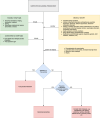Delusions of Parasitosis: An Update
- PMID: 31520344
- PMCID: PMC6828902
- DOI: 10.1007/s13555-019-00324-3
Delusions of Parasitosis: An Update
Abstract
Delusional parasitosis, also known as delusional infestation or Ekbom syndrome, is a relatively infrequent psychotic disorder characterized by an unwavering false belief that there is a parasitic infestation of the skin, despite the absence of any medical evidence that could support this claim. Delusional parasitosis can be categorized into primary, secondary, and organic forms. Sometimes, close relatives also experience identical delusions. This phenomenon was reported to occur in 5-15% of cases, and is known as shared psychotic disorder-delusional parasitosis with folie à deux. Patients with delusional parasitosis frequently seek help from many physicians. Close multidisciplinary cooperation between clinicians is often key to shortening the time taken to diagnose this disorder. Initiation of psychopharmacological therapy is a challenge, as many patients refuse any psychiatric treatment because of the stigma associated with mental illness and because of their firm belief that they have a parasitic infestation, not a psychiatric condition. For many patients, a sense of a lack of understanding leads to isolation and the development of depression symptoms, which is why it is crucial to earn the trust of such patients while taking care of them.
Keywords: Delusional infestations; Delusional parasitosis; Ekbom syndrome; Neuroleptics.
Conflict of interest statement
Adam Reich has worked as a consultant or speaker for AbbVie, Bioderma, Celgene, Chema Elektromet, Eli Lilly, Galderma, Janssen, Leo Pharma, Medac, Menlo Therapeutics, Novartis, Pierre-Fabre, Sandoz, and Trevi, and participated as Principal Investigator or Subinvestigator in clinical trials sponsored by AbbVie, Drug Delivery Solutions Ltd, Galderma, Genentech, Janssen, Kymab Limited, Leo Pharma, Menlo Therapeutics, MetrioPharm, MSD, Novartis, Pfizer, and Trevi. Dominika Kwiatkowska and Przemysław Pacan have nothing to disclose. Adam Reich is a member of the journal’s Editorial Board.
Figures
References
-
- Harth W, Gieler U, Kusnir D, Tausk F. Clinical management in psychodermatology. Berlin: Springer; 2009.
Publication types
LinkOut - more resources
Full Text Sources




